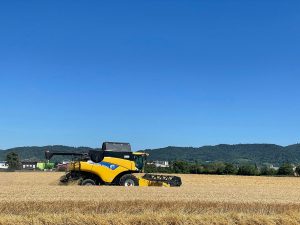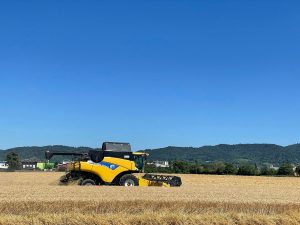The export of agricultural machinery presents unique challenges when it comes to collecting payments, especially across international borders. Legal complexities, communication barriers, financial implications, and specific industry issues all play a role in shaping the strategies for debt recovery. This article delves into these challenges, outlining the legal framework, communication strategies, financial considerations, and a structured three-phase recovery system, as well as the specific difficulties encountered in agricultural machinery export payment collection.
Key Takeaways
- A thorough understanding of international debt collection laws and the role of local attorneys is crucial for navigating jurisdictional variations and assessing the viability of legal action.
- Effective debtor communication requires multiple contact methods, skip tracing, investigation, and skilled negotiation to reach payment resolutions.
- Financial considerations, such as analyzing collection rates, evaluating legal costs, and the impact of debt age and amount, are essential for a cost-effective debt recovery process.
- The three-phase recovery system involves initial contact and demand for payment, attorney-based collection efforts, and a litigation recommendation stage, with specific actions and decisions required at each phase.
- Collecting payments for agricultural machinery exports is particularly challenging due to industry-specific issues, cross-border payment delays, and defaults, necessitating tailored collection strategies.
Understanding the Legal Framework for International Debt Collection
Navigating Jurisdictional Variations
When we dive into the complexities of international debt collection, we’re immediately confronted with a labyrinth of legal systems. Each country’s laws dictate how we can pursue outstanding debts, making jurisdictional variations a critical factor. We must adapt our strategies to align with local regulations, which often requires the expertise of local attorneys.
Our approach is methodical. We start by identifying the debtor’s location and the applicable legal framework. Here’s a snapshot of our initial steps:
- Determine the debtor’s jurisdiction and governing laws
- Assess the enforceability of the debt within that jurisdiction
- Engage with local legal experts to navigate the legal landscape
Timely payments are not just a matter of good business practice; they’re essential for maintaining the flow of agricultural machinery exports. Delays can disrupt not only individual transactions but also the broader market stability.
In this global dance of debt recovery, one misstep can lead to a cascade of complications. We’re here to guide you through each step, ensuring that your rights as a creditor are upheld across borders.
The Role of Local Attorneys in Debt Recovery
We understand the pivotal role local attorneys play in the debt recovery process. Their expertise in local laws and procedures is invaluable when navigating the complex terrain of international debt collection. Local attorneys bridge the gap between different legal systems, ensuring that our strategies for debt collection in machinery exports are aligned with the jurisdictional requirements.
Skip tracing and thorough investigation lay the groundwork for effective debt recovery. Our affiliated attorneys are instrumental in these initial phases, providing the necessary legal leverage to move towards a resolution. When legal action becomes a necessity, they are our front line, drafting demands and engaging with debtors directly.
Our decision to proceed with litigation is never taken lightly. It hinges on a careful evaluation of the debtor’s assets and the likelihood of recovery.
Here’s a snapshot of our attorney-based collection efforts:
- Initial investigation and assessment of debtor’s assets
- Drafting and sending demand letters
- Direct engagement with debtors through calls and correspondence
- Evaluation of the case for litigation recommendation
Our collaboration with local attorneys is not just about legal muscle; it’s about crafting a nuanced approach that considers the viability of recovery and the financial implications for our clients.
Assessing the Viability of Legal Action
When we face overdue payments, our approach is methodical. We assess each case on its own merits, considering the debtor’s assets and the surrounding facts. If recovery seems unlikely, we advise closing the case, incurring no cost to you. Conversely, if litigation appears viable, a decision looms.
Choosing not to litigate means you can withdraw the claim without owing us. Alternatively, we can persist with standard collection efforts. Opting for legal action necessitates upfront costs, typically $600-$700, covering court and filing fees. Our affiliated attorney then champions your cause, seeking all monies owed.
Our rates are competitive, structured to the age and amount of the debt, and the number of claims. The percentage of the amount collected varies, ensuring fairness and transparency in our partnership.
Here’s a snapshot of our fee structure:
- Accounts under 1 year: 30% (1-9 claims) or 27% (10+ claims)
- Accounts over 1 year: 40% (1-9 claims) or 35% (10+ claims)
- Accounts under $1000.00: 50% regardless of claim count
- Accounts placed with an attorney: 50% across the board
In the realm of international debt collection, strategies for tackling overdue payments in various industries are crucial. Our tailored approach ensures that your efforts in agricultural machinery exports are not in vain.
Strategies for Effective Communication with Debtors
Utilizing Multiple Contact Methods
In our pursuit of overdue payments, we’ve learned that diversity in contact methods is crucial. We don’t just rely on traditional phone calls; we embrace emails, texts, and even social media outreach when appropriate. It’s about being where the debtors are, increasing the chances of a response.
Persistence is key. Our approach includes:
- Daily attempts in the initial phase
- A mix of communication channels
- Adapting to debtor’s preferred contact methods
We’re not just persistent; we’re strategic. By varying our tactics, we avoid debtor fatigue and maintain pressure for payment.
Our strategies are not one-size-fits-all. They’re tailored to the specifics of each case, much like the nuanced approaches discussed for tackling overdue payments in the food and beverage exports and recovering debts in the USA-Canada chemical industry trade. Legal actions and collection rates are always considered, ensuring we’re efficient and effective.
The Importance of Skip Tracing and Investigation
We understand the pivotal role of skip tracing and investigation in the debt recovery process. Identifying the debtor’s assets and whereabouts is crucial to the success of any collection effort. Here’s how we tackle it:
- We initiate skip tracing within 24 hours of account placement.
- Our team employs various tools to gather financial and contact information.
- We make daily attempts to reach the debtor, using all available communication methods.
Persistence in investigation not only increases the chances of recovery but also informs the feasibility of legal action.
When all else fails, we escalate to our network of local attorneys, ensuring that no stone is left unturned in the pursuit of what’s owed.
Negotiating Payment Resolutions
When we’re at the negotiating table, our goal is to strike a balance between firmness and flexibility. We craft payment plans that align with both our clients’ needs and the debtor’s capabilities. It’s a delicate dance, but one that often leads to mutually beneficial outcomes.
Persistence is key. We follow up relentlessly, ensuring that debtors understand the seriousness of their situation. Our approach is methodical:
- Establish clear communication lines.
- Present reasonable yet firm payment options.
- Set deadlines and follow through.
We’re not just chasing payments; we’re building bridges for future business stability.
Our experience shows that when debtors are approached with respect and understanding, they are more likely to cooperate. We’ve seen success in various industries, including tackling overdue payments in the food and beverage exports and recovering debts in the USA-Canada chemical industry trade. Legal actions and recovery processes are always emphasized as a last resort, not a first step.
Financial Considerations in Debt Recovery
Analyzing Collection Rates and Fees
We understand that the bottom line matters. Our collection rates are tailored to the complexity and age of the debt, ensuring you get the most cost-effective service. For newer accounts, the fees are more favorable, reflecting the higher likelihood of recovery. As debts age, the rates increase, accounting for the additional effort required.
Here’s a quick breakdown of our fee structure:
| Age of Account | Number of Claims | Collection Rate |
|---|---|---|
| Under 1 year | 1-9 | 30% |
| Over 1 year | 1-9 | 40% |
| Under $1000 | 1-9 | 50% |
| Any Age | 10+ | 27%-35% |
Legal action fees are a separate consideration, typically ranging from $600 to $700. These are upfront costs covering court and filing fees, necessary when we transition to litigation.
We strive to keep costs transparent and aligned with your recovery prospects. Our competitive rates reflect our commitment to your success in debt recovery.
Remember, timely payments are not just about maintaining cash flow; they’re about sustaining the environmental technology and food/beverage sectors we serve.
Evaluating the Costs of Legal Action
When we reach the crossroads of legal action, the financial stakes are high. We must weigh the potential recovery against the upfront costs. These costs can range from $600 to $700, depending on the debtor’s jurisdiction, covering court costs, filing fees, and more.
Options for legal action in Phase Three are clear-cut: proceed with litigation by paying upfront costs or withdraw the claim with no fees. Our other posts delve into timely payments, financial disputes, overdue payments, and debt recovery across industries.
Our rates are competitive, yet they vary based on the age and amount of the debt, as well as the number of claims. Here’s a quick breakdown:
-
For 1-9 claims, expect:
- Accounts under 1 year: 30% of the amount collected.
- Accounts over 1 year: 40% of the amount collected.
- Accounts under $1000: 50% of the amount collected.
- Accounts placed with an attorney: 50% of the amount collected.
-
For 10 or more claims:
- Accounts under 1 year: 27% of the amount collected.
- Accounts over 1 year: 35% of the amount collected.
- Accounts under $1000: 40% of the amount collected.
- Accounts placed with an attorney: 50% of the amount collected.
Deciding to litigate is not just about the potential to recover funds; it’s a strategic decision that impacts our resources and future relations with debtors.
Impact of Debt Age and Amount on Recovery Efforts
The age and amount of debt significantly influence our recovery strategies and success rates. Older debts are notoriously more challenging to collect, with a marked decrease in recovery likelihood as time passes. It’s a race against the clock, and prompt action is crucial.
Debt amount also plays a pivotal role. Smaller debts, especially those under $1,000, often incur higher collection rates due to the disproportionate effort required relative to the potential recovery. Conversely, larger debts may warrant the additional resources and legal maneuvers necessary to secure payment.
Our fee structure reflects these realities:
- Accounts under 1 year: More favorable collection rates.
- Accounts over 1 year: Increased rates to offset diminished recovery prospects.
- Small debts under $1,000: Highest rates due to effort versus return considerations.
We must balance the cost of collection against the potential return, ensuring that our efforts are both strategic and economically sound.
The Three-Phase Recovery System Explained
Initial Contact and Demand for Payment
JSON:
{
"content": [
"We hit the ground running with our three-phase Recovery System. Phase One kicks off within 24 hours of account placement. Here’s what we do:",
"- Send the first of four letters via US Mail.",
"- Conduct skip tracing and investigations to secure top-notch financial and contact information.",
"- Leverage phone calls, emails, text messages, and faxes to reach a resolution.",
"Daily attempts to contact the debtor are a given for the first 30 to 60 days. If these efforts don’t bear fruit, we escalate to Phase Two, engaging local attorneys in the debtor’s jurisdiction.",
"> If all attempts to resolve the account fail, we go to Phase Two, where we immediately forward the case to one of our affiliated attorneys within the debtor’s jurisdiction.",
"Our initial contact is crucial—it sets the tone for the entire recovery process. We’re persistent but professional, always aiming for a swift and satisfactory resolution."
]
}
Transition to Attorney-Based Collection Efforts
When our initial recovery attempts hit a wall, we escalate to the legal phase. Our affiliated attorneys step in, armed with the authority to demand payment through official channels. The shift to legal action is a critical juncture in our three-phase recovery system, signaling a more serious approach to debt collection.
We assess each case meticulously, considering the debtor’s assets and the likelihood of recovery. If the prospects are dim, we advise closing the case, sparing you unnecessary costs.
Our rates for collection services are tailored to the specifics of each claim. Here’s a snapshot of our fee structure based on the age and amount of the account:
- Accounts under 1 year: 30% (1-9 claims) or 27% (10+ claims) of the amount collected.
- Accounts over 1 year: 40% (1-9 claims) or 35% (10+ claims) of the amount collected.
- Accounts under $1000: 50% of the amount collected.
- Accounts requiring attorney involvement: 50% of the amount collected.
Should litigation be the recommended path, you’ll face a decision. If you opt for legal action, upfront costs will apply. However, if our litigation efforts don’t pan out, you owe us nothing further.
Decision Making at the Litigation Recommendation Stage
At this critical juncture, we face a pivotal decision. Should we advance to litigation or not? The choice hinges on a meticulous assessment of the debtor’s assets and the likelihood of recovery. If prospects seem dim, we’ll advise case closure, sparing you further costs.
When litigation appears viable, and you opt to proceed, be prepared for upfront legal expenses. These typically range from $600 to $700, covering court costs and filing fees. Our affiliated attorney then champions your cause, seeking full recompense.
Our commitment is to transparency in fees and a tailored approach to collection rates. The age and size of the debt influence our competitive rates, ensuring fairness and clarity.
Here’s a snapshot of our fee structure:
-
For 1-9 claims:
- Accounts under 1 year: 30% of the amount collected.
- Accounts over 1 year: 40% of the amount collected.
- Accounts under $1000.00: 50% of the amount collected.
- Accounts with attorney involvement: 50% of the amount collected.
-
For 10 or more claims:
- Accounts under 1 year: 27% of the amount collected.
- Accounts over 1 year: 35% of the amount collected.
- Accounts under $1000.00: 40% of the amount collected.
- Accounts with attorney involvement: 50% of the amount collected.
The decision to litigate is not taken lightly. We weigh every factor, from the feasibility of recovery to the financial implications, ensuring you’re equipped with all necessary information to make an informed choice.
Challenges in Agricultural Machinery Export Payment Collection
Understanding the Specifics of Agricultural Machinery Exports
When we delve into the realm of agricultural machinery exports, we’re not just talking about moving heavy equipment across borders. We’re dealing with complex transactions that intertwine with various international regulations and payment terms. Understanding these specifics is crucial for effective debt recovery.
Our experience shows that agricultural machinery often involves larger sums and longer credit terms, which can complicate the collection process. Here’s a snapshot of what we face:
- Extended payment schedules
- Varied international warranty claims
- Diverse financing arrangements
- Fluctuating currency exchange rates
We must adapt our strategies to accommodate these unique challenges, ensuring we remain proactive and vigilant in our collection efforts.
Factors affecting collection rates include claims submitted, account age and amount, attorney involvement. Other posts discuss timely payments in environmental tech exports, financial disputes in telecom trade with Canada, tackling overdue payments in food and beverage exports, and recovering debts in USA-Canada chemical industry trade.
Dealing with Cross-Border Payment Delays and Defaults
When we face cross-border payment delays and defaults, our approach must be both strategic and adaptable. We prioritize understanding the debtor’s circumstances and aim to establish a dialogue that encourages resolution. It’s essential to recognize that each case is unique, and a one-size-fits-all strategy is rarely effective.
Our experience shows that communication is key. We employ a variety of contact methods to ensure that our message reaches the debtor. This may include phone calls, emails, and even physical letters. Persistence in communication often leads to a breakthrough.
In the event of persistent non-payment, we must assess the situation carefully. The age and amount of the debt can significantly influence our recovery efforts.
We also consider the financial implications of pursuing legal action. Here’s a quick breakdown of our collection rates:
- Accounts under 1 year in age: 30% of the amount collected.
- Accounts over 1 year in age: 40% of the amount collected.
- Accounts under $1000.00: 50% of the amount collected.
- Accounts placed with an attorney: 50% of the amount collected.
These rates are competitive and tailored to the specifics of the agricultural machinery export industry. By understanding these nuances, we can better navigate the challenges of cross-border payment collection.
Adapting Collection Strategies to Industry-Specific Issues
In the realm of agricultural machinery exports, we must tailor our collection strategies to address unique industry challenges. We recognize that a one-size-fits-all approach falls short when dealing with the intricacies of international trade in this sector. Our strategies are dynamic, evolving with the shifting landscapes of global markets and regulatory environments.
To ensure the highest recovery rates, we adapt our methods to reflect the specific nature of agricultural machinery transactions. This includes understanding the seasonal cash flow patterns of our clients’ debtors and the economic pressures they face.
Our experience has taught us that the key to successful debt recovery lies in the details. For instance, the strategies for tackling overdue payments in food and beverage exports and enforcing payment terms in the textile export industry are discussed in this article. We apply this nuanced understanding to our agricultural machinery export clients, ensuring that our collection efforts are both empathetic and effective.
Here’s a snapshot of our tailored approach:
- Initial assessment of debtor’s financial health and payment history
- Strategic timing of communication to align with agricultural cycles
- Flexible payment arrangements that consider the debtor’s cash flow
By customizing our approach, we not only enhance our chances of successful recovery but also maintain the delicate balance of client-debtor relationships, which is crucial for future business dealings.
Navigating the complexities of agricultural machinery export payment collection can be a daunting task. With the myriad of international laws, currency fluctuations, and the risk of non-payment, it’s crucial to have a reliable partner to ensure your financial interests are protected. At Debt Collectors International, we specialize in providing tailored debt collection solutions that simplify the recovery process. Don’t let unpaid debts hinder your business growth. Visit our website to learn more about our services and how we can assist you in securing your payments efficiently. Take the first step towards safeguarding your revenue today!
Frequently Asked Questions
What happens during the first phase of the three-phase recovery system for debt collection?
In Phase One, within 24 hours of placing an account, a series of four letters are sent to the debtor, the case is skip-traced and investigated for financial and contact information, and collectors attempt to contact the debtor using various methods. Daily attempts are made for the first 30 to 60 days to resolve the matter.
What occurs if attempts to collect a debt fail in Phase One?
If all attempts to resolve the account fail during Phase One, the case progresses to Phase Two, where it is forwarded to one of our affiliated attorneys within the debtor’s jurisdiction for further action, including drafting demand letters and making contact attempts.
What are the possible outcomes of Phase Three in the debt collection process?
In Phase Three, the outcome is either closure of the case if recovery is unlikely, or a recommendation for litigation. If litigation is chosen, upfront legal costs must be paid, and a lawsuit is filed on your behalf. If litigation attempts fail, the case is closed and nothing is owed to the firm or attorney.
What are the collection rates for debts under the three-phase recovery system?
Collection rates vary depending on the number of claims and the age and amount of the account. They range from 27% to 50% of the amount collected, with specific rates for accounts under 1 year, over 1 year, under $1000, and those placed with an attorney.
Are there any upfront costs associated with proceeding to litigation in debt recovery?
Yes, if litigation is recommended and chosen, you are required to pay upfront legal costs such as court costs and filing fees, which typically range from $600.00 to $700.00, depending on the debtor’s jurisdiction.
How does the age and amount of a debt affect the recovery efforts and fees?
The age and amount of a debt impact the collection rates, with higher rates for older accounts and lower amounts. For example, accounts under $1000 or over 1 year in age have higher collection rates due to the increased difficulty in recovery.





